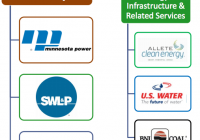ALLETE, Inc: Diversified Utility Seeking New Growth Areas
Summary The company just acquired another new wind facility. The company acquired U.S. water earlier in the year which will drive sales growth. 88% of revenue comes from its regulated utility side. It doesn’t get much more boring than ALLETE, Inc (NYSE: ALE ). The diversified utility based in Minnesota is pretty predictable considering 88% of its revenue is from its regulated utilities. It has been seeking new growth areas as of late. It has taken several steps to aid growth that look quite promising. This new diversification, a solid regulated business, and attractive dividend make ALLETE a great long-term pick in the utilities sector. Stepping back and looking at the company as a whole it is easy to see that it is a very diversified utility. Although it generates 88% of its revenue through its regulated business it also has several other segments. Below is the breakdown of the company’s holdings. (Source: ALLETE ) The regulated business has helped the company achieve steady growth over the past couple of years. This is illustrated by the fact that between 2010 and 2014 earnings grew at a compounded annual rate of 6.7%. All the while the company has been diversifying its portfolio. Through the small reoccurring growth in its regulated business and the higher growth possibilities in its other segments the company is forecasting annual EPS growth of 5% for the next couple of years. Along with this it also expresses that it will keep its dividend competitive and growing. Currently the shares sport a 4.3% yield making it very attractive to dividend investors. Specifically there are two areas which should take the company’s growth to the next level. Below I outline what the company is doing in terms of growing its portfolio and diversifying its business. U.S. Water The best example of the company further diversifying its portfolio is when earlier this year it aquired U.S Water. U.S Water is a integrated water management company that provides solutions to many industrial and commercial clients. The company serves clients nationwide and serves many Fortune 500 companies. (Source: ALLETE ) It has increased its customer base from 2,141 in 2011 to over 3,600 in 2014. It also has an excellent track record of retaining these customers with over 90% of customer being retained. In 2014 U.S Water did $120M in sales which the company forecasts will increase between 10-15% annually over the next few years. Considering ALLETE only has revenue of $1.16B in 2014 this is a very significant addition to the business. On top of that growing it at 15% would mean the company expects it to be pulling in nearly $160M by the end of 2016. U.S. Water continues to retain clients and add reoccurring revenue which compliments the regulated part of ALLETE’s business well. ALLETE Clean Energy Renewable energy has become even more popular in recent years as well as more economical. ALLETE has been expanding its clean energy business as it attempts to make its business more diversified and less reliant on fossil fuels. Over the past year it has increasingly built up its presence in this area, particularly in wind generation. This past November the company agreed to actually develop a wind farm for Montana-Dakota Utilities, which is a division of MDU Resources Group (NYSE: MDU ). In the agreement it will end up selling the wind farm to MDU for $200M. While I couldn’t locate the exact amount of capital the company will need to put into the development it did make it clear in the quarter one confrence call that it will have an effect on earnings. It should be noted that the effect of these earnings have not been factored into the earnings guidance the company has given thus far. Other than developing wind farms it has also been acquiring them for its own portfolio. Below are the wind farm aquistions the company has completed over the past couple of months. In December closed a deal to acquire 108 MW facility in Iowa. In January closed a deal to acquire 3 wind farms in 3 different states from AES Corp. (NYSE: AES ). In April closed a deal to acquire 98 MW facility from EDF Renewable. In June closed another deal with AES to acquire 101 MW facility in Pennsylvania. With the latest acquisition the company now has over 500 MW of wind generation in operation. Seeing as it has acquired majority of these this year it should be interesting to see the company grow this business in the next couple of years. In the conference call the company touched upon that it will also see positive effects for the year from these clean energy acquisitions. However, it expects its gains in this area to only offset the losses from the steel industry dynamics that face its Minnesota Power business. Conclusion ALLETE is further diversifying its portfolio to seek new areas of growth. Although it has yet to see positive effects from the newest acquisitions it should start to see them as the year progresses. With these new growth opportunities as well as an extremely strong regulated business to lean on it expects to deliver 5% earnings growth over the next couple of years. This should translate into further dividend growth adding attractiveness to the already high yield of 4.3%. I think as a long-term play ALLETE is making the right moves making itself more diversified and seeking new growth areas. Disclosure: I am/we are long AES. (More…) I wrote this article myself, and it expresses my own opinions. I am not receiving compensation for it (other than from Seeking Alpha). I have no business relationship with any company whose stock is mentioned in this article. Additional disclosure: Always do your own research before investing.

